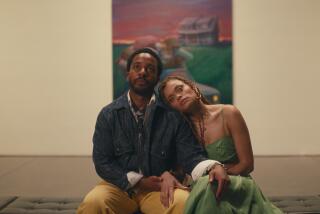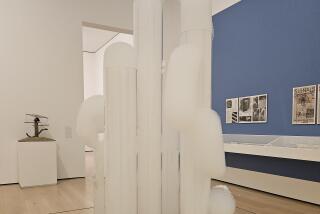Private Moments, Precisely Observed
The mystique that hangs so heavily around the figure of Rembrandt was, to some extent, of his own design. He played up his humble origins and cultivated a reputation as a renegade. He lived high, when he could, and died cash-poor. Questions of attribution clouded his work even in his own day, making its value and authenticity slippery matters of continual debate.
His art, on the other hand, has never been much concerned with mystery and intrigue. It’s about the real thing. Honest to the physical world and of penetrating psychological depth, it elevates truth to human experience above all else. Myth, religion and the more distanced verities of history permeate Rembrandt’s work, but gain their credibility only through the convincing representation of individual experience.
Rembrandt’s profound humanism comes across immediately in “The Age of Rembrandt: Etchings From Holland’s Golden Century,” at the San Diego Museum of Art. A sequence of his small, emotionally dense portraits opens the show, setting a tone of interior reflection and a standard of sheer visual radiance that remain unmatched among the 13 lesser names and, for the most part, lesser talents included. It’s a modest show--just 49 prints in all--of small-sized works, but it illustrates well the styles that prevailed during Rembrandt’s lifetime (1606-1669) and how brilliantly he transcended them.
It was through etchings that Rembrandt’s fame first spread internationally. Portable and affordable, prints (engravings, primarily) were conventionally made as knockoffs of paintings, a lucrative way to stretch the mileage on a painting commission. Rembrandt invested printmaking with greater import and was seminal in the etching’s rise as an expressive, self-sufficient medium. He often printed his etchings in various states, altering and refining them with dry point or engraving to intensify their effect.
This show, organized by the San Diego Museum of Art’s Steven Kern, drawing in part from the museum’s collection, doesn’t dwell on the artist’s technical experimentation as much as it surveys the range of themes he explored in the nearly 400 etchings he made in his lifetime.
Only 14 of those prints appear here, but several are stellar examples of his craft and sensibility. A tiny portrait of the artist’s mother, presumably in mourning, could fit in the palm of one hand, but evokes a vast sense of emptiness and grief. A neighboring image of preacher Jan Cornelisz Sylvius is similarly concentrated, and webbed to overall darkness with fine crosshatching. The preacher’s eyes and brow, however, gleam in that darkness. Their luminosity compels attention, articulating through light the sitter’s sensitivity and intellect.
Rembrandt’s dramatic use of chiaroscuro--contrast of light and shade--has often been identified as theatrical, and yet it serves more often to illuminate a private reckoning than a public spectacle. There’s a great interiority to Rembrandt’s portraits that extends, as well, to many of his narrative scenes.
The soulful self-scrutiny that appears to go on in these portraits is matched by Rembrandt’s clear-eyed observation of the skin of things. He was honest to a fault, favoring bluntness over flattery. He relished the real thing. “Diana Bathing” is typical of his earthy portrayal of women in the nude. Snubbing the classical ideal, Rembrandt casts his Roman goddess of the hunt as a fairly plain-faced woman, complete with familiar lumps and sags. Whether he’s meaning to bring the gods down to Earth or to raise up the human to the level of the divine, the effect is the same--she is an individual who mirrors the viewer’s reality.
Rembrandt’s attention to particularities gives even his religious images the feel of genre painting. In “Christ Preaching,” the divine and the earthly meet again. A diverse group of young and old, upright and stooped encircle Christ, attentive to his words--all but a child in the foreground, who lies on his belly facing away from the orator, drawing in the dust with his finger. He’s immersed in an alternate world. Because Rembrandt has drawn each of the members of this small assembly so vividly and variably, it’s clear that they too each possess their own world of concern rather than simply standing in as props to reflect the glory of their teacher.
Genre painting came of age in Holland during Rembrandt’s time, a period of terrific prosperity. The United Provinces of the Netherlands declared independence from Spain in 1648. At the time, as the show’s attractive little catalog points out, Holland was the richest country in Europe and possessed the continent’s largest port. The country’s middle class had emerged as a formidable constituency, and the art of everyday life enjoyed broad appeal.
Several of the non-Rembrandt highlights in the show are genre studies. Adriaen van Ostade’s “Child Reaching for a Doll” is charming and well-observed. The same artist’s “Peasant Family,” a domestic interior, gurgles with detail. In Cornelis Dusart’s “The Village Fair,” dogs, dancers and drinkers cavort across an earthen stage with celebratory abandon. Cornelis Bega’s half-completed etching of a tavern scene has a quiet, studied integrity. And Jacob van Ruisdael’s country scene of a man and his dog crossing a bridge behind a rickety, straw-roofed house abounds in social texture.
Marcus de Bije’s studies of leopards and Nicolaes Berchem’s portraits of goats merely dilute the show’s energy, but otherwise the supporting cast does what a supporting cast is supposed to do: contribute a measure of character and energy, and leave lots of room for the star to shine.
And shine he does.
The urgency of Rembrandt’s line and the intensity of his light and shadow make the other works here feel noncommittal in comparison. There is never anything neutral in Rembrandt. Even what seems like a straightforward landscape, his etching “The Three Trees,” abounds in strongly held opinions. Breathtakingly beautiful, it shows a trio of trees on a riverbank and an expansive flat plain behind. A storm approaches as a heavy whisper along the print’s left edge, but the trees band together like family, united against the coming threat. Rembrandt articulates their fused foliage with a knowing intimacy, the condition of endurance being, after all, familiar and human. *
*
“THE AGE OF REMBRANDT: ETCHINGS FROM HOLLAND’S GOLDEN CENTURY,” San Diego Museum of Art, 1450 El Prado, Balboa Park, San Diego. Dates: Tuesdays-Sundays, 10 a.m.-6 p.m.; Thursdays, 10 a.m-9 p.m. Through Jan. 13. Prices: $8; $6, students, adults 18-24, seniors, military with ID; $3, children 6-17; free, children younger than 5. Through Jan. 13. Phone: (619) 232-7931.
More to Read
The biggest entertainment stories
Get our big stories about Hollywood, film, television, music, arts, culture and more right in your inbox as soon as they publish.
You may occasionally receive promotional content from the Los Angeles Times.










